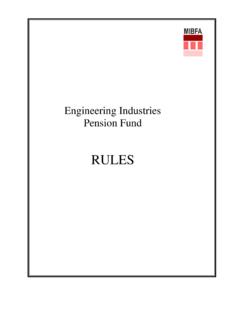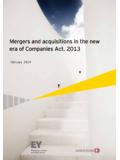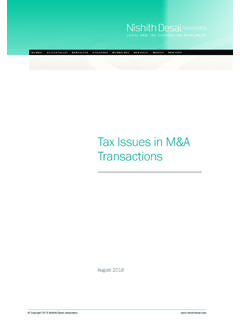Transcription of State of Play: Jobactive Employment Services 2015 …
1 Page 1 1. BACKGROUND The outcomes of the tender for new Employment Services contracts were announced on Tuesday, 31 March 2015. The new Services , which are to be called Jobactive , replace the existing Job Services Australia (JSA) contracts and will run from 1 July 2015 to 30 June 2020. The announcement marks the conclusion of a process that began as far back as 2012, when the then Department of Education, Employment and Workplace Relations published its first issues paper , seeking feedback and ideas to improve JSA. Following the 2013 Federal Election, the new Assistant Minister for Employment , the Hon.
2 Luke Hartsuyker MP, held a series of informal, invitation-only round-table discussions seeking further feedback from some stakeholders. The Minister also attended the 2013 Jobs Australia National Conference, where we presented our own proposals from our Blueprint for the Future, and attended various other forums and meetings with Jobs Australia and its members. The new model was revealed with the publication of an Exposure Draft Request for Tender on 28 July 2014, followed by the final Request for Tender on 7 October, 2014. Key facts and figures JSA Jobactive Provider orgs 79 44 NFP share (approx.)
3 70% 55% Contract regions 110 51 Sites 1,889 1,719 Term 2 x 3 yrs 5 yrs % of funds up-front 65% 40% % of funds in outcomes 35% 60% State of Play: Jobactive Employment Services 2015-2020 Tender Results 231 92 93 95 64 64 59 55 79 55 41 59 58 55 29 13 11 9 8 8 8 8 7 7 7 6 6 6 MAX EmploymentThe Salvation Army Employment PlusSarina Russo Job AccessAdvanced Personnel Management (APM)Job ProspectsMission ProvidenceMatchWorksWorkskil AustraliaSureway Employment and Training Pty LtdTursa Employment & TrainingJob Futures LtdNEATO Employment Services Pty LtdMADEC AustraliaEmployment Services GroupChart 1.
4 How the new 'market' looks Site countRegion CountChart shows site and region counts for the 14 providers that won contracts in more than 5 regions. Darker bars have been used for non-profit organisations. Page 2 2. KEY THEMES AND TRENDS There is now a significant history of contracted out Employment Services in Australia, starting with contracted-out case management Services under the Keating Government s Working Nation package (mid 1990s), through the three iterations of the Job Network (1998-2009), followed by the JSA years (2009-present) and bringing us to the new Jobactive model (2015-2020).
5 Many trends can be observed over this time. Some of the main ones are summarised below. CONSOLIDATION OF PROVIDERS The number of providers has consolidated from around 300 at the beginning of the Job Network (1998), to around 100 at the start of JSA (2009), to around 80 at the end of 2014 and now down to 44 (possibly fewer, if some reject their offers) for Jobactive . This could be said to be a consequence of other trends described in this section. SHIFT OF RISK TO PROVIDERS There has been a trend away from fee-for-service arrangements in favour of outcome-based payment models.
6 The new Jobactive model shifts the payment model further towards outcomes: under JSA, only around 1/3 of the total funding was contingent on outcomes, whereas the Jobactive funding model appears to make something like 50-60% of the funding contingent on achieving outcomes. By shifting the payment model towards outcomes, the Government is shifting more of the financial risk onto providers. LESS MONEY Associated with the shift of risk (above) and the drive for increased accountability (see below), the financial arrangements have tightened over time.
7 While the cost of delivering the Services always increases (broadly in line with inflation), extra administrative requirements add extra back-of-house costs and the price that Government pays for Services has only ever stayed the same or been reduced. We estimate that the overall funding in Financial risk in the new model The following chart illustrates some of the risk in the new model. Chart 2: five year cash flow (hypothetical) The chart shows a hypothetical example, generated with Jobs Australia s Cash Flow Calculator, with significant investment in year 1 of the contract, followed by four years of stable costs.
8 The income assumptions are a caseload of 1,000 job seekers per year; with 50% of those obtaining Employment ; 50% of job places leading to a 4 week outcome; 50% of those leading to a 12 week outcome; and 50% of those leading to a 26 week outcome. These assumptions are purely hypothetical. The Cash Flow Calculator multiplies out the fee model based on these assumptions to generate the chart. The chart shows how the income generated by outcome payments winds up over time. This example starts generating an annual profit in year 2 of the contract but it is not until year 4 that the provider would recover the up-front investment from year 1.
9 The projections would obviously be affected by any of the following: A business reallocation (scheduled for 18 months and 36 months) An economic downturn or local labour market shift A shift in costs Contract variations / guideline changes that affect costs or income (increases in red tape etc) Problems with a partner organisation or subcontractor -$1,000,000-$800,000-$600,000-$400,000-$ 200,000$0$200,000$400,000$600,000$800,00 0$1,000,0002015-162016-172017-182018-192 019-20 Cumulative Profit/LossCash InflowsCash OutflowsAnnual Profit/LossPage 3 the Jobactive model has been reduced by 10% to 15% compared to JSA.
10 ACCOUNTABILITY / RED TAPE AND FLEXIBILITY The Employment Services contracts have always contained a complex mix of incentives, and, unfortunately, some providers have, in the past, responded to those incentives by seeking to game the contracts. Scandals have been widely reported in the media, and governments have been embarrassed and pressured to respond with increased accountability measures. The consequence has been ever-increasing administrative requirements (with some notable but small attempts to reduce administrative burden from time to time largely in response to industry pressure).



